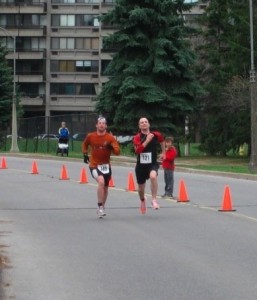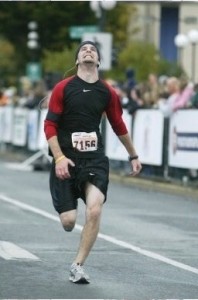For many athletes, “carb-loading” is a pre-race ritual. And with good reason: carbohydrate is an important fuel for exercise, whether you’re running for a personal best or to complete a particular distance. But before you put on your extra-loose pants and head for the nearest all-you-can-eat pasta bar, let’s ask a few questions.
What is carb-loading and why is it done?
Your body uses carbohydrate and fat to perform exercise. Even a very lean athlete has a virtually unlimited supply of stored fat for exercise, but a very small supply of carbohydrate (stored as glycogen in the muscle and liver). During exercise, the faster you want to go, the more carbohydrate you will require. Additionally, the further you go, the more carbohydrate you will eventually use, even though you aren’t using as much at any given time. In endurance exercise, muscle glycogen can become so depleted that you may be forced to significantly reduce your pace. By consuming a larger-than-normal amount of carbohydrates before exercise, you can slightly increase muscle glycogen stores in order to delay, or eliminate, the need to drastically reduce pace.
What distance of race calls for carb-loading?
If you’re aiming to complete your first 5k race, or to establish a new personal best in the 10k, proper rest and a normal diet will ensure you have enough carbohydrate on board to achieve your goal. Cancel the party-size sub for one.
If you are aiming to do a half-marathon, things are a bit less clear. Lab research suggests that carb-loading could benefit athletes exercising for more than 90 minutes, particularly if your goal is to complete the distance as quickly as possible. But there really haven’t been enough studies done to determine just what kind of half-marathoner can benefit from carb-loading. It may be best to conclude for now that if you’re aiming for a PB in the half marathon, carb-loading is a good option as long as you don’t overdo it. Otherwise, go with the previous advice of proper rest and a normal pre-race diet. Maybe someone reading this has some personal experience (or maybe some group data!) to share?
If your goal distance is the marathon, then you will almost definitely benefit from pre-race carb-loading. Intensity and duration combine to determine how much muscle glycogen you will use, and whether you risk depleting it in your race. Elite male marathoners can complete 42.2 km in just over 2 hours, but because of their ability to maintain such a high exercise intensity (which requires more carbohydrate), they will deplete their muscle glycogen quickly. A runner aiming to complete a marathon in 4 hours won’t use as much carbohydrate at any given time, but will spend more time running, and will start with less muscle glycogen than the elite runner. In both cases, muscle glycogen will likely become depleted late in the race, before the finish.
To sum things up, if you have run a marathon and it seemed pretty hard in the last couple kilometers, you would have benefited from pre-race carb loading. Disclaimer: I do not provide any sort of guarantee that carb-loading will make the last few kilometers of a marathon any easier; you just might not slow down so much.
How much carbohydrate do I need to eat? For how long?
It seems like there are two types of carb-loading athletes. There is the common “night-before pasta-eater” (let’s call her Tracy) who gathers with fellow athletes for one last meal before the big day. Then there is the rare and elusive “week-long suffer-fester” (let’s call him Olaf), who swears by a protocol of several days of intense exercise with very low carb intake to deplete muscle glycogen, and then several days of reduced training and carb-loading to increase carb storage beyond normal values. You could argue that Olaf’s technique might result in higher pre-race glycogen concentration, and you could argue that Tracy’s technique might result in a more functional member of society during the week, with a slightly submaximal glycogen concentration on the weekend.
Is there a way for us to maximize pre-race muscle glycogen concentration while keeping our day jobs? Olaf’s technique is based on research from 40 years ago, and there have been a few updates since then. The current recommendations call for no “depletion phase”, and a brief 36-48-hour period of carb-loading before the event. That’s much more reasonable. But for those of us who wouldn’t mind an even shorter loading period, let’s look a bit deeper.
In 2002, “endurance-trained” athletes ate 10 grams of carbohydrate per kg body mass per day, over 3 days of rest. Muscle glycogen concentration reached a maximal level after just one day, remaining constant over the next 2 days. The researchers concluded that one day of carb-loading, combined with rest, is enough to optimally load the muscle with glycogen.
OK, so we’ve got it down to one day of loading. Great. But 10 grams per kg body mass? For someone who weighs 80kg (~175lbs), that’s 800 grams of carbs, or about 50 slices of bread! Let’s see if we can do something about this.
A 2011 study compared finishing times of two large groups of runners at the London Marathon. Average finishing time of the entire athlete pool was 4.5 hours, which is very comparable to average finishing time at most marathons. The day before the event, one group had eaten less than 7 grams of carbs per kg body mass, while the other group had eaten more than 7. No measures of muscle glycogen concentration were taken, but the group that had eaten more pre-race carbs ran over 10% faster than the group that ate fewer carbs. That’s a difference of about half an hour!
So it appears we have a compromise. For optimal pre-exercise carb-loading, you should start earlier and be more consistent with intake than Tracy, but you don’t need to go nuts like Olaf. Let’s arrive at this recommendation: Try to eat between 7-10 grams of carbohydrate per kg body mass per day, over 1-2 days before your event. Err on the higher carb side if you eat a good amount of carbohydrates on a daily basis, and on the lower side if you don’t normally eat a ton of carbs. An even lower amount of carbohydrate may still be effective for someone who has a low daily carb intake. In terms of time frame, favour the shorter protocol if you’re busy. You don’t want to have to explain to your partner how you got fired because you skipped work on Friday to down a couple pounds of potatoes.
Next time: The logistical (and social) challenges of actually consuming more than 7 grams of carbohydrate per kg body mass in one day. Find out if I chose to diversify beyond my requisite 34 slices of bread.
References
Ahlborg B et al. Human muscle glycogen content and capacity for prolonged exercise after different diets. Forsvarsmedicin 1967;3:85-99
Atkinson G et al. Pre-race dietary carbohydrate intake can independently influence sub-elite marathon running performance. Int J Sports Med 2011;32:611-17
Bussau VA et al. Carbohydrate loading in human muscle: an improved 1 day protocol. Eur J Appl Physiol 2002;87:290-95
Hawley JA et al. Carbohydrate-loading and exercise peformance. An update. Sports Med 1997;24:73-81







 Our Magazine
Our Magazine Previous Release
Previous Release
